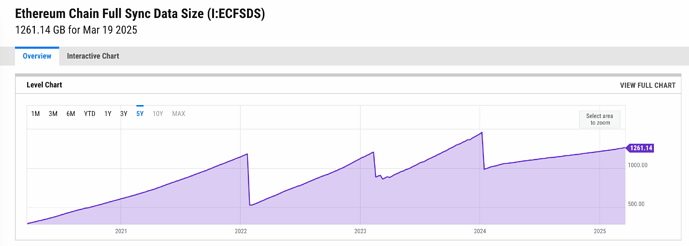EIP-4444 was written at a time (2021) when historical block state growth was still an issue. Today, the L1 isn’t even being used anymore! We’re sub 1 gwei gas!! We’re seeing a much slower growth of the total size of the sync because of less activity on L1 and blobs. The motivation for EIP-4444 is outdated! This is what EIP-4444 says in its Motivation
Historical blocks and receipts currently occupy more than 400GB of disk space (and growing!). Therefore, to validate the chain, users must typically have a 1TB disk.
This is arguably less of a concern in 2025. As you can see below, the full chain sync data size is growing at a much slower rate than what it was when EIP-4444 was written. Please update your priors.
Also, if you haven’t already, I invite you to read the comments for EIP-4444. The community hates this proposal and there are many people who have come out against it. Their arguments in summary:
- Storage costs have decreased significantly - 4TB SSDs now cost ~$280, making historical storage more affordable
- Storage capacity grows faster than blockchain size - The relative burden is smaller over time
- Post-Dencun architecture has reduced data growth - Block sizes and daily history growth have decreased
- Breaks Ethereum’s promise of data persistence - Undermines the “unstoppable apps” value proposition
- Canonical transaction history is a core value - Critical to Ethereum’s fundamental utility
- External solutions have proven unreliable - TheGraph has demonstrated censorship issues
- Creates new centralization risks - Forces reliance on potentially centralized data providers
- Degrades developer and user experience - Breaks uniform access interfaces for historical data
- Damages DeFi ecosystem - Could reduce DeFi to permissioned fintech services
- Alternative economic models exist - Storage could be incentivized through fees or staking
- Historical data has inherent market value - Reduced supply may create natural incentives
- Breaks existing applications - Many dApps depend on historical data access
Do you suggest to argue away the community’s concerns? Do you think they are all wrong? I don’t.
I completely agree that there will never be complete consensus. But have you read the EIP-4444 comments? The roughly consensus is that nobody wants it and the EIP has since then been stagnant.
To me “going through the ACD process” is not creating legitimacy around the issue. Nobody but people who are paid to work on this software can afford to go to all of these calls to argue against certain roadmap items. Again I’m an app developer, not a core dev. If you also know anything about my app’s funding model you will know that my money is anyways earned by delivering a good app to consumers, not to play the politics in ACD calls. Clearly then the concerns in the Ethereum Magicians forum have to be heard and taken seriously.
This tweet was posted on 5 Nov 2022. IMO it is not relevant anymore either. Look at the financial fundamentals of Ethereum:
The fact is that due to the L2 roadmap now fee accrual has come down significantly in 2025. We’re on track to only make $300M, down from $2.4B and even 4 and 9 billion! That’s an order of magnitude LESS in 2025! Maybe you make good money in the Protocol Guild aside from your EF salary, I’m locked into only ETH prices rising!
It is pretty clear that we can’t just blindly continue to execute Vitalik’s roadmap diagram anymore as we have to cater to the issues that we’re having today, which are that fee accrual is basically now broken for Ethereum. So that has to be fixed first before there is any further legitimacy in following the technical vision of the founder. If that roadmap is followed there’ll just be further deterioration in price because fee accrual won’t fix itself.
Even Vitalik has since then admitted that L2s aren’t super useful for everything we want to do with Ethereum: Reasons to have higher L1 gas limits even in an L2-heavy Ethereum
Fundamentally L2s are really just a temporary transactional layer that you should exit after you’ve done your business. They are really useful for trading memecoins. And his post also admits that it’s effortful, at best, to bolt-on more use cases to the existing rollup design or to make it safer e.g. for L2 issuance.
I think if we want to grow fee accrual again we have to develop calldata beyond just increasing its cost. Calldata is what got rollups started. And as I’ve said, blobs and L2s are a narrow solution to transacting scalar values cheaper. But they don’t solve other use cases the L1 services. Please do acknowledge this.
I’m obviously not surprised by the state expiry roadmap. I’m against The Purge part of that roadmap and I have been for a while.
There are many applications which have been building for years on Ethereum and which are not served well with e.g. the dumb formulations in EIP-4444
Historical data can be packaged and shared via torrent magnet links or over networks like IPFS. Furthermore, systems like the Portal Network or The Graph can be used to acquire historical data.
Why are Ethereum core devs shilling me The Graph or IPFS? Or Torrents? This level of not-giving-a-fuck really makes me mad. The Graph, IPFS, Torrents, they all suck!
There is a very good reason I do not use these systems today in my dapps. Torrents and IPFS have literally existed for the entirety of time while Ethereum has existed. If they are so great, naturally dapp developers would have adopted them in the meantime, don’t you think?

